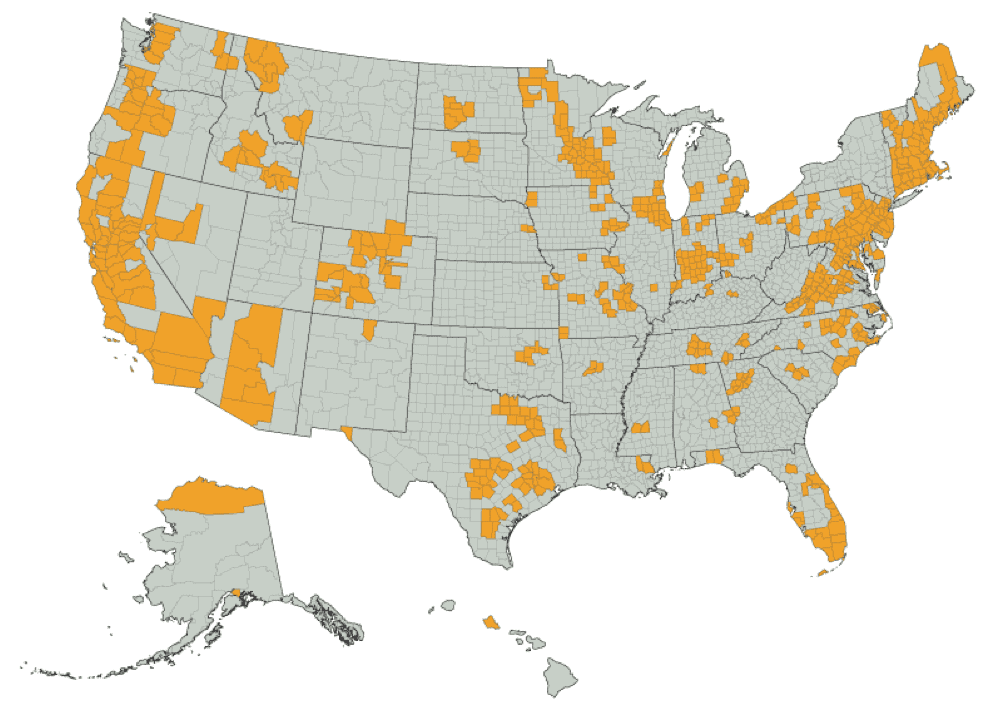Borreliosis can refer to two distinct but similar diseases caused by subspecies of the spiral-shaped bacteria Borrelia: Lyme disease and Tick-Borne Relapsing Fever (TBRF). As the two most common diseases spread by Borrelia, Lyme and TBRF present significant challenges to patients and the medical establishment alike. Each disease is spread by several different subspecies of Borrelia, both share symptoms that can make diagnosis difficult, and both are growing in prevalence and spreading geographically. And in recent years, estimates from the Centers for Disease Control and Prevention (CDC) have shown that TBRF and Lyme disease are more common than was previously assumed.
How common is Lyme disease?
Lyme disease is not only the most well-known tick-borne illness – it is also the most common. Spread by spiral-shaped bacteria of the genus Borrelia, it is transmitted by hard ticks throughout the U.S. and causes symptoms such as fever, fatigue, arthritic joint pain, and sometimes a “bull’s eye” rash. Though Lyme disease is treatable with antibiotics, untreated Lyme can be extremely dangerous, leading to neurological symptoms, chronic Lyme, or even death.
As of 2013, the official number of cases of Lyme disease reported to the CDC annually hovered around 30,000. Then the CDC came out with a new estimate, positing that the actual number of cases was likely closer to 300,000 – ten times the number of reported cases. In other words, Lyme disease is much more common than most people once thought.
In 2017, there were 42,743 cases of Lyme disease reported to the CDC, a 17% jump from the 2016 number. Using the CDC’s formula of 10x the number of reported cases, that would mean there are now approximately 427,000 Lyme disease cases per year, and its presence appears to be expanding geographically. IGeneX Laboratory has tested patients with Lyme disease in all 50 states. It’s clear that Lyme disease is not only on the rise, but also that there is still a significant gap between the public’s understanding of how common Lyme disease is and the true threat of the disease.
Why the discrepancy between reported cases and the CDC’s actual estimates?
“We know that routine surveillance only gives us part of the picture,” said the chief of epidemiology and surveillance for CDC’s Lyme disease program, Paul Mead, M.D., back when the 300,000 figure first came out. One reason is that much public health research on infectious diseases relies primarily on cases reported by doctors, entirely missing cases that go unreported, undiagnosed, or misdiagnosed. To arrive at a more accurate (and ultimately much larger) estimate of how common Lyme disease is, the CDC instead used data from health insurance claims, clinical laboratories, and public surveys.
How common is Tick-Borne Relapsing Fever (TBRF)?
Between 1990 and 2011, the CDC cited 483 reported cases of TBRF in the Western states where TBRF was reportable. But this number excludes cases that may be present outside those states, as well as unreported or misdiagnosed cases. Also, this is before the discovery of B. miyamotoi in the U.S. TBRF is present worldwide, including 49 of the 50 U.S. states.
Caused by a group of species of Borrelia closely related to the species of Borrelia which cause Lyme, TBRF can often “look like Lyme and behave like Lyme,” creating complications when it comes to accurately diagnosing the tick-borne infectious disease – as well as accurately reporting on how common TBRF really is.
Where are Lyme Disease and TBRF most common?
Lyme disease is present in North America, Europe, the Middle East, and parts of Asia and Australia. In the U.S., Lyme was once thought to be confined to the Northeast and Upper Midwest and is still most common there, but over the past twenty years it has spread and shown up in all 50 states.

Geographic distribution of Lyme disease in the United States.
Unlike Lyme, TBRF is spread by hard and soft ticks – soft ticks feed more quickly than hard ticks –. One hard tick TBRF species, B. miyamotoi, is found in the U.S., Europe, Russia, and Japan, while soft tick TBRF species (B. hermsii, B. parkeri, B. turicatae, etc) are prevalent in North America, Europe, Asia, the Middle East, Africa, Central and South America, and Australia.
In the U.S., most cases of TBRF are associated with sleeping in rustic cabins during warm months and are reported in 14 Western states: Arizona, California, Colorado, Idaho, Kansas, Montana, Nevada, New Mexico, Oklahoma, Oregon, Texas, Utah, Washington, and Wyoming. However, IGeneX has found TBRF in 49 of 50 states, and the CDC says cases are known to have occurred during winter months.

Geographic distribution of Tick-Borne Relapsing Fever in the United States.
Why Newer CDC Estimates Matter
With the 300,000 estimate from 2013, the CDC’s Lyme disease program acknowledged that the new research showed Lyme disease to be a “tremendous public health problem” that highlighted the need for greater prevention efforts. The gap in numbers also sheds light on the many cases each year that go un- or misdiagnosed, leaving a community of patients suffering (and risking the worsening of their conditions) without proper treatment.
Remember that delaying treatment can give a tick-borne disease time to progress, become harder to diagnose, or become chronic or even life-threatening. The IgXSpot test from IGeneX detects certain tick-borne diseases in their early stages, giving you a head-start on seeking treatment after you’ve been bitten by a tick. If you think you may be at risk for Lyme disease, TBRF, or another tick-borne infectious disease, learn how to get tested with IGeneX today.








